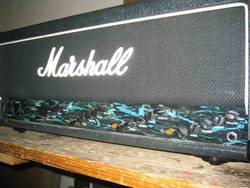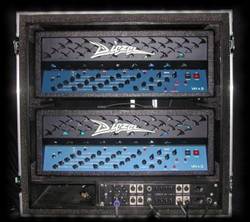
It started like so many other boutique companies: Peter Diezel, playing in one of Munich's rockbands in the 80s, wasn't too satisfied with his Marshalls, modded them and after a while more and more players contacted him to get his mods.
At that time he was famous for tweaking amps on stage during gigs . . . But the limitations of the "Marshall-platform" were too frustrating not to try a new concept: midi-switchable, four channel amp. Luckily Peter D. met Peter Stapfer, a pro-musician with a strong sales/marketing background, who was ready to build up a company of its own:
Diezel Amplification
The company was still located in Munich. Peter D. was manufacturing and Peter S. the head of sales. The first amp, which is still on the market (a bit tweaked over the decade) was launched in 1994 - the milestone VH4. Of course Munich's music scene was more than keen to get them. But the success was limited to germany and austria - and the legend says that one single VH4 made it to a studio in LA - the beginning of a new area for Diezel Amplification. More and more big acts (like Metallica, Guns & Roses) started to record with the VH4 and so the US fell in love with the Diezel trademark sound.
Late in the 90s the music scene changed - hard/heavy rock was on its way down and the amp market was asking for a more modern concept. Peter D. then started to work on a new sonic monster, still with all the common Diezel-features like midi, switchable loops. He finished the prototypes in 2001 and got more than enthusiastic feedbacks from his customers during NAMM/Frankfurt Music Fairs.
2002 the new model called "Herbert" (named after Peter Diezel`s father) was introduced. The amp was more powerful than the VH4, with similar features, but an innovative new concept: a mid-cut section, which made "evil" sounds with the flick of a switch accessable in an amp, which could also do all the classical guitar amp sounds.
In 2003 the lab/factory was moved from Munich to Bad Steben, located in the north-east of Bavaria and Peter's home town, where he is working and living now. The company still is based on a family & friends level.

Autumn 2004 the (previous) official website was finished and could spread Diezel news, clips and detailed information what was going on in Bad Steben into the bits and bytes of the World Wide Web.
With Herbert and VH4 available in more shops worldwide, the users demanded for a stripped down but still highest quality amp. So the idea for a twin channel amp was born . .
In 2005 the new model called after Diezel`s dog Einstein was launched on NAMM. Einstein comes in three configurations: 100 or 50 Watt head and 50 Watt combo.
German speaking readers may want to have a look at the more detailed Portrait of the company, which was published by "Gitarre und Bass" magazine - you'll find the PDF-file in the reviews menu.
In 2006 Columbus was launched. It is the Diezel way how to build a midi pedal: overcrafted, simple to use and indestructable.
Another highlight was the launch of Diezels first Class A amplifier, Schmidt, in 2009. While most players at that time were rockers and metal guys, Schmidt opened the doors to Diezel country for blues. jazz and country players.
Additionally with Schmidt Peter integrated a new footswitching technology into Schmidt (and following amps), which provides midi date theu a standard mono-guitar cable. It is used for the FS5S and lately the FS5H, which is the footswitch for . . .
2009 the production of cabinets was put up in Dillingen, were Peter Stapfer now builds all the headshells, cabs and other parts like the bottom of the FS5S switches.
"Hagen", first time hit the stage during 2011 Frankfurt Musikmesse. Keeping in mind that the VH4 was first presented in 1994, the demands of modern guitarists (different tunings f.i.) have changed over the decades. Hagen is Diezels answer to the needs of modern axemen, offering a wide range of sounds in a box, which is typical Diezel, filled with useful features.
